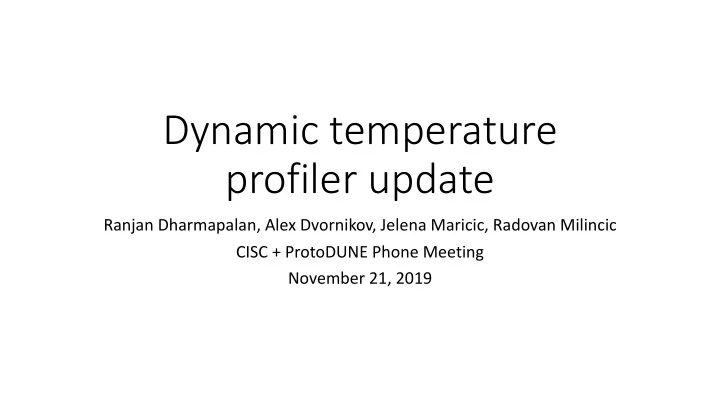

Dynamic temperature profiler update Ranjan Dharmapalan, Alex Dvornikov, Jelena Maricic, Radovan Milincic CISC + ProtoDUNE Phone Meeting November 21, 2019
Dynamic Temperature Profiler New Design Motivation • Current design allows cross-referencing of the sensors in-situ, but the same sensors DO NOT sample the entire height of the detector. • Issue for calibrating the static sensors as well. • Due to the high precision requirement for the temperature gradient measurement and adverse effects of the ambient temperature variation that cannot completely be calibrated out, it is desirable to come up with an alternative design that will move the common set of sensors through the entire height of the detector to maximize the measurement precision. 2
Temperature Profiler Overview Cryostat top Guide wire Wall attachment Static T-monitor • Consists of movable array of 5 sensors and static temperature sensor array next to it. • 5 sensor attached to a single point on the Guide wire, cable. Kept under Slight tension • Cable moves up and down over the entire Cable conduit cryostat height ~14 m. 1 cm diameter • Weight attached to the bottom of the cable minimizes lateral motion. • Two guides, one on each side of the movable sensor array restrict lateral swing. • One of the guides serves as a static temperature array with sensors spaced every Rod guides to limit 25 cm over the entire TPC height and Lateral motion protective net to allow guide to move smoothly. Guide wire Wall attachment 3 Weight
Cable conduit Stepper motor anchor point Motion mechanism Viewport Slow on the control back side • Use similar motion mechanism as before • Stepper motor drive • Ferrofluidic seal to transfer Flange with the rotary motion to the Sensor spool feedthroughs • Drawings and step file of the Cable conduit funnel motor drive received from Cary. Sensor Cables conduit 4
Pulley and Deployment off center from stepper motor the flange and through the cross if flange is shared Cryostat top Guide wire Wall attachment • This design enables deployment Pulleys off center from the flange with Guide wire, engagement of additional Kept under pulleys Slight tension • Pulleys do not need to rotate Static T-monitor Cable conduit but should be of the material 1 cm diameter that minimizes friction as the Rod guides cable conduit moves over them • Guide wire Wall attachment 5 Weight
Sensor Board Top view Design Overview 5 cm • Set of 5 sensors, closely spaced Sensor with Cutout around • Attached to the rod that moves along the entire 14 m height of the detector • While 1 sensor would suffice, 5 sensors are placed for redundancy and to account for potential failures. • Sensors placed on a common PCB carrier rod. • Use connectors (like in a static profiler) to connect sensors to cables. Side view 6
Static temperature profiler design • Design will heavily rely on the static profiler experience from ProtoDUNE • Place sensors every 25 cm for a total of ~56 sensors. • Requires dedicated flange with electric feedthroughs. • Sensors will be surrounded by Faraday cage that will also ensure smooth motion of guides across array. • May require wire tensioner to eliminate sagging of the carrier (no design details yet). 7
Design status and implementation • Need engineering work to produce a more technical conceptual design and integrate it with the DUNE module 3D model • Three options currently being pursued (no dedicted engineering funds available) • 1) Hawaii machinist Roger with engineering experience can work on the design, but not integration with DUNE 3D model – free of charge • 2) Hawaii engineer Christian Miki who works for another faculty may be available to work on it part time –experienced user of SoidEdge, thus, can perform integration with the cryostate model – moderate cost • 3) ANL engineer Victor Guarino may be available to do engineering work – higher cost 8
Uodated Cost of Dynamic + Static T-gradient Profiler Item Cost ($) (dynmic) Cost ($) (static) Materials, total 30,000 15,000 Prototyping 15,000 2,000 Shipping, crating 5,000 5,000 Engineering 60,000 0 Travel 9,000 0 Total (for 2 units) 149,000 44,000 The total cost estimated at $200k for 2 systems of combined dynamic and static monitor. 9
Future steps • Critical part: integration of the combined static and dynamic array in the 3 d model. • Combine existing motion mechanism design with the fishline system • Identify suitable anchor points for the guidewires • Identify whether there is a need for the off-axis installation with the respect to the dedicated flange. 10
11
Cryostat top Guide wire Sensor rod motion mechanism Wall attachment • 5 sensor cables grouped together inside Static T-monitor cable conduit • Cable conduit has 1 cm diameter Guide wire, Kept under • Cable conduit contains thin (1.5 mm diameter) Slight tension stainless steel cable to avoid cable sagging Cable conduit • Cable conduit and the stainless steel cable is 1 cm diameter attached to the top of the sensor rod to eliminate stress on the cables (Chinese fingers or some similar system) • Cable conduit flexible and perforated to eliminate gas pockets. • Weight on the bottom of the sensor rod keeps the cable conduit under tension (also account for buoyancy in LAr). Rod guides to limit • Guide wire limits the upward motion of the Lateral motion sensors. Motor current is limited. • Guide wire near the static array. Guide wire Wall attachment 12 Weight
Recommend
More recommend